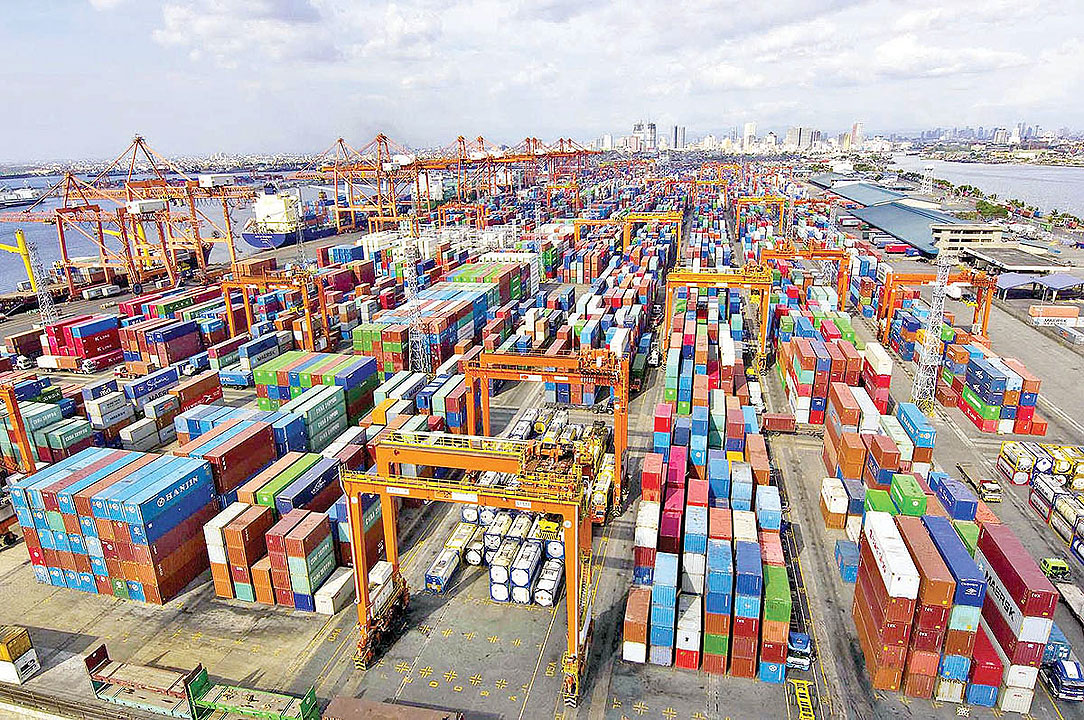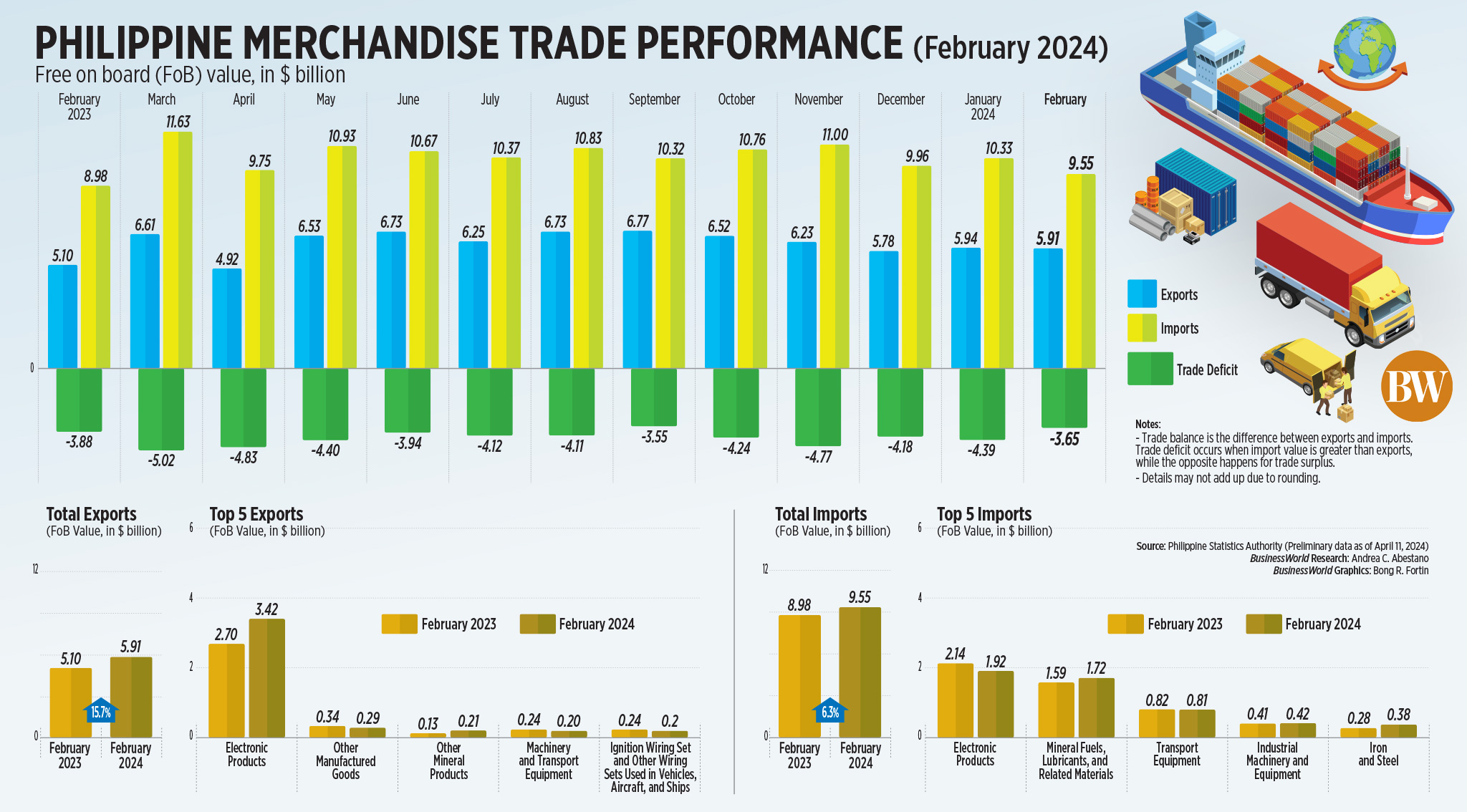Trade deficit narrows to $3.65B in Feb.

Lourdes O. Pilar, Researcher
THE PHILIPPINES posted a trade deficit of $3.65 billion in February, the slimmest in five months, as exports and imports both grew at the fastest pace in 16 months, data from the statistics office showed.
Preliminary data from the Philippine Statistics Authority (PSA) showed the country’s trade-in-goods balance — the difference between exports and imports — stood at a $3.65-billion deficit in February, slipping by 6% from the $3.88-billion gap in February last year.
Month on month, the trade gap also narrowed from the revised $4.39 billion in January.
The trade deficit in February was the smallest in five months or since the $3.55-billion deficit in September last year.
Outbound sale of goods expanded for the second straight month by 15.7% annually to $5.91 billion in February. This was faster than the revised 9.1% growth in January and a turnaround from the 18.3% decline in February last year.
This was the quickest exports growth in 16 months or since the 20.6% surge in October 2022.
Meanwhile, imports rose by 6.3% to $9.55 billion in February, ending two months of decline. This was a turnaround from the revised 6.1% contraction in January and the 11.8% decline in February 2023.
Imports growth was also the fastest in 16 months or since 7.7% in October 2022.
In the first two months of 2024, the trade deficit narrowed by 14.9% to $8.04 billion from the $9.44-billion gap in the same period last year.
Exports accelerated by 12.3% to $11.84 billion in the January-to-February period, while imports slipped by 0.5% to $19.88 billion.
The Development Budget Coordination Committee (DBCC) projects 3% and 4% growth in exports and imports, respectively, this year.
“Export jump was driven largely by the surge in electronics exports with the Philippines tracking the rebound in regional peers as demand for chips picks up,” ING Bank N.V. Manila Senior Economist Nicholas Antonio T. Mapa said in an e-mail.
He noted imports ended mixed in February as “corporates and the government are holding back on big-ticket items due to expensive borrowing costs.”
Manufactured goods, which accounted for the bulk of the country’s total export receipts, rose by 14.9% year on year to $4.88 billion in February.
Electronic products, which made up nearly three-fourths of manufactured goods and more than half of total exports in February, increased by 26.8% to $3.42 billion. Almost half of total exports came from semiconductors, which jumped by 31.9% to $2.64 billion.
Exports of mineral products also expanded by 23.4% to $456.46 million in February.
Meanwhile, imports of raw materials and intermediate goods in February grew by 11.8% to $3.49 billion. These accounted for 36.5% of the total February import bill.
In February, imports of capital goods declined by 3.4% to $2.55 billion, while the imports of consumer goods grew by 9.2% to $1.75 billion.
Imports of mineral fuels, lubricants and related materials picked up by 8.3% year on year to $1.72 billion.
“We expect more of the same with exports likely taking their cue from the mainstay electronics subsector which could continue to see demand for components. Meanwhile, imports should grow as imported energy prices are on the uptick while consumer demand remains robust,” said Mr. Mapa.
The government targets for exports and imports are achievable given the expectations for soft global trade in the coming months, he said.
“One trend that has yet to reverse, however, is the sustained struggles of capital imports, which are a lead indicator of future growth and show the expansion of potential output. This is likely due to the elevated and restrictive monetary policy stance of the Philippines, which has held back our growth prospects,” Mr. Mapa said.
The United States was the main destination of Philippine-made goods in February, accounting for 16% or $947.83 million in export sales.
Other top export destinations were Japan, which accounted for 14.4% or $849.17 million and Hong Kong, which accounted for 13.1% or $774.03 million.
Meanwhile, China was the top source of imports, accounting for 22.8% of the total or $2.18 billion of the total import bill in February.
It was followed by Japan with an 8.8% share or $845.23 million and South Korea with 7.5% or $719.90 million.
Philippine Exporters Confederation, Inc. President Sergio R. Ortiz-Luis, Jr. said that trade did well in February as geopolitical tensions eased and exports registered growth.
“Some of the problems in geopolitics and issues in shipping began to go down, fuel prices are also going down. Exports are expanding, though slowly, especially in the area of electronics,” Mr. Ortiz-Luis said in a phone interview.
He said he expects the trend to continue in March.

